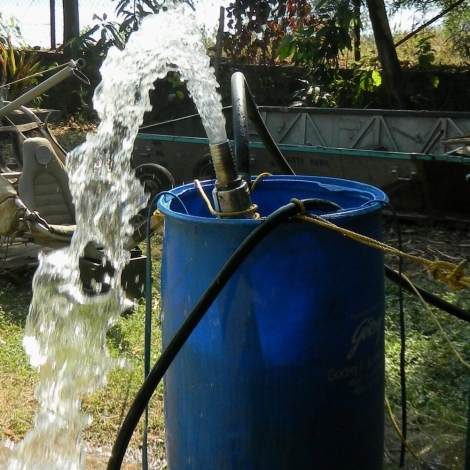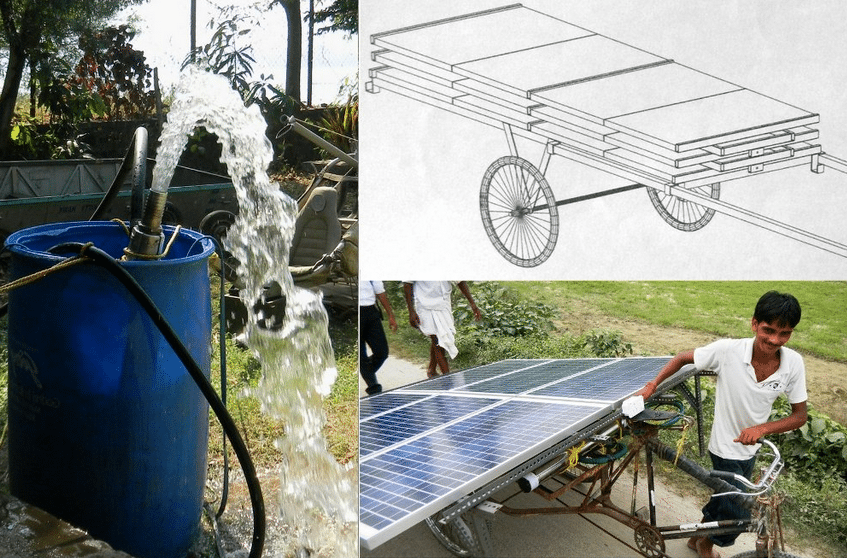
This demo shows technology proposed for a battery-less, portable, high-flow solar PV pump that won Greenpeace’s design contest. This pump can deliver 70,000 liters from a 4in bore hole, its designers say. Photo courtesy of Eric Jensen and Vivek Mundkur
With the votes tallied at Greenpeace’s water pump design contest it’s safe to say that two trends have emerged in Indian farm technology: Solar panels and simplicity. The Energy [R]evolution Challenge offered prizes totaling €30,000 for clean-tech pump designs to replace the five-horsepower diesel pumps that are popular on farms in Bihar in southern India. The criteria included low-cost, efficiency and portability. The dream-team jury included 14 international experts in water technology, renewable energy, finance and development. And they combed through 250 entries to choose simple,workable solar-powered pumps to take their first three prizes.
First and second place prizes went to two concepts for solar-powered immersible pumps, and third went to a solar-powered pump powered by a brushless DC motor.
Contest planners take note: Greenpeace’s unusual format may have improved the quality of the submissions. During the ten-week contest, designers posted their ideas to a public forum at Jovoto where their competitors, the judges and anyone else could see. Then, if they were lucky, their posts gathered comments and advice for improvement. The designers could use the feedback to change their ideas as much as they wanted before the clock ran out. It was a crowd-sourced effort, and it ultimately created the winning design.
Drumroll, please…
The Simple Solar Pump for India took the jury’s first place prize and sprang from an online collaboration between two engineers who met through comments on eachother’s posts. Eric Jensen, an agricultural engineer in Canada, and Vivek Mundkur, a retired engineer in India won €8000 in prizes to develop their prototype.
“It’s an idea built upon experience and solid analysis, with potential to rapid prototype and move to mass production,” said Dr. Robert Yoder of iDE, one of the 14 experts on the jury.
Contest planners take note: Greenpeace’s unusual format may have improved the quality of the submissions.
Second place prizes totaling €3750 went to The Solar Pump for Bihar, which Mundkur, who had a hand in the top two finishers, designed on his own.
The Solar-Panel-Powered Portable Water Pump won third place prizes of €2250. The designer, Balázs Gábor Nagy, got his start building furniture, audio hardware, cosmetics and other goods at home in communist Hungary in the 1980s. Now he builds his own solar panels. For the contest, Nagy took advice from comments posted on his original submission and improved his design to make it easier to manufacture.
Solar rising
Photovoltaics were not the only power source considered among the entries. Wind, geothermal, passive solar, biogas, bicycles and hybrid combinations also ran. The people’s choice went to one of those, The Low-Cost Solar and Biomass Hybrid Pump.
But the judges chose solar panels, adding their votes to the tide of solar power rising in rural and off-the-grid communities.
Next up, farmers will work with prototypes of the winning designs and offer advice on how to make them better. Then after tweaks and refinements, the optimized designs will debut before manufacturers and distributors in a Clean Pumping Fair in India this spring.
“These pumps will create a new market segment – the clean-powered, portable, cheap pump for small farmers – as a viable alternative to expensive, dirty diesel pumps,” Ingo Boltz, manager of the Greenpeace Innovation Lab, said in a statement.
Related resources
Gallery: 15 concepts to replace diesel-powered water pumps on Indian farms
Ideas have streamed into Greenpeace’s challenge to reimagine the renewable energy irrigation pump and win €30,000 to develop the design.
Is a low-priced solar irrigation pump on the horizon?
Paul Polak and the SunWater project have a plan to cut the cost of solar irrigation pumps by 80 percent.
Ten low-tech ways to irrigate crops
Drips, furrows, pots and pumps, these are 10 low-cost devices that grow more crops.

